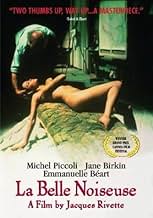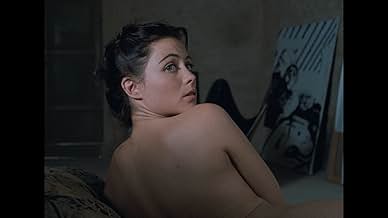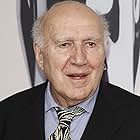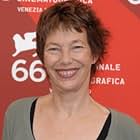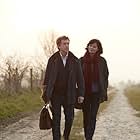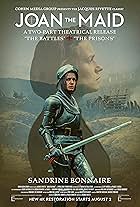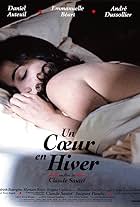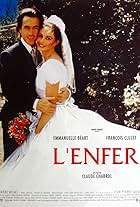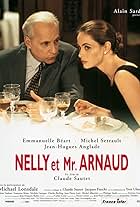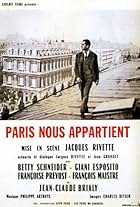IMDb RATING
7.5/10
9.7K
YOUR RATING
The former famous painter Frenhofer revisits an abandoned project using the girlfriend of a young visiting artist. Questions about truth, life, and artistic limits are explored.The former famous painter Frenhofer revisits an abandoned project using the girlfriend of a young visiting artist. Questions about truth, life, and artistic limits are explored.The former famous painter Frenhofer revisits an abandoned project using the girlfriend of a young visiting artist. Questions about truth, life, and artistic limits are explored.
- Awards
- 5 wins & 6 nominations
Daphne Goodfellow
- Deux touristes
- (as Daphné Goodfellow)
Storyline
Did you know
- TriviaThere was no script per se. The film was shot in sequential order and the day's shooting was dictated by what had been filmed the day before.
- GoofsAt the 2:13 mark (blu-ray edition) - as the camera begins to slowly close on Marianne settling on the couch, a mic sneaks into bottom of frame.
- Crazy creditsTous les dessins et peintures d'Edouard Frenhofer sont l'oeuvre de Bernard Dufour. All the drawings and paintings of Edouard Frenhofer are the work of Bernard Dufour.
- Alternate versionsShort version (125 minutes, less nudity, brighter lighting, almost different takes and editing) titled "Divertimento" showing for TV, then released theatrically in 1993.
- SoundtracksAgon
Music by Igor Stravinsky
Performed by Sinfonie-Orchester des Südwestfunks (as Orchestre de Südwestfunk de Baden-Baden)
Conducted by Hans Rosbaud
(avec l'autorisation des disques Adès)
Featured review
Having seen "Va Savoir" recently prompted me to rent Jacques Rivette's 1990 "La Belle Noiseuse," a daunting runtime of 240 minutes (though I noticed it was only 3 hr. 48 mins.) It's well worth the time and experience. An experience in painting - nude figure drawing to be precise. But it's not a film merely about lessons in nude figure modeling from the beautiful Emmanuelle Béart, or meticulous details of an artist's painting process from veteran actor Michel Piccoli, there is a Rivette storyline depicting multiple relationships, himself literally painting us psychological pictures/sketches. He's truly the French filmic master of human predicaments between man and woman. Rivette has such visions, skillful techniques, and superb craft in telling his story with thoughtful details - never misses a beat.
The beginning scenes put us in a comfortable rural setting outside of Paris - beautiful open views of the village town, captures of the villa architectural interiors, and tastes of the lovely airy gardens and shady greens exterior. Yes, there are plenty of dialogs, but the inclusion of real-time ambient and environmental sounds made "La Belle Noiseuse" experience whole. It has the most wonderful ordinary sound of the studio door with latch creak opens and closes - it comes so naturally. There's the pen nib scratching against the sketchpad paper, the chalk against the surface of a canvas, even the quick ruffling of sheets when Béart the model swivel-turned in defiance - such detailed little sounds simply add to the flavor and tone of the story. We see two pairs of relationship and then some: between the mature and weathered pair of Edouard Frenhofer the painter and Liz his wife (who used to be his favorite model) portrayed by Michel Piccoli and Jane Birkin; the younger set Marianne and Nicolas, yet to absorb the trials and zest of life, portrayed by Emmanuelle Béart and David Bursztein; then the twists of the mercurial commercial-minded Balthazar Porbus, the unrelenting insistent Nicolas' sister Julienne, with gentle relieving pauses from young Magali, daughter of housekeeper Francoise, not to forget Justine the Cat.
Other then an Igor Stravinsky piece used for the beginning/ending credit roll, and Magali's brief morning ballet exercise, there's really no background music used. The occasional church bell rings, sounds of cicada and rustling leaves provided serene accents. Much is said in the unsaid, and the ending portion sure makes one wonder and prompts reflections. Rivette has a flair for unsuspecting ending drama, almost philosophical, or could it be renewed beginnings?
The paintings/drawings were from the hands of Bernard Dufour. Cinematography by William Lubtchansky, especially inside the studio, captured the critical chiaroscuro (light and shadows) of drawing/modeling sessions. Michel Piccoli is a regular in Luis Bunuel films; "Belle de Jour" 1967, with Catherine Deneuve is one example. Jane Birkin has such a gentle yet fortified disposition; she's in Bertrand Tavernier's "Daddy Nostalgia" 1990, opposite Dirk Bogarde. I really enjoy Emmanuelle Béart's performance in Claude Sautet's "Nelly et Monsieur Arnaud" 1995, with Michel Serrault, who was equally brilliant.
The beginning scenes put us in a comfortable rural setting outside of Paris - beautiful open views of the village town, captures of the villa architectural interiors, and tastes of the lovely airy gardens and shady greens exterior. Yes, there are plenty of dialogs, but the inclusion of real-time ambient and environmental sounds made "La Belle Noiseuse" experience whole. It has the most wonderful ordinary sound of the studio door with latch creak opens and closes - it comes so naturally. There's the pen nib scratching against the sketchpad paper, the chalk against the surface of a canvas, even the quick ruffling of sheets when Béart the model swivel-turned in defiance - such detailed little sounds simply add to the flavor and tone of the story. We see two pairs of relationship and then some: between the mature and weathered pair of Edouard Frenhofer the painter and Liz his wife (who used to be his favorite model) portrayed by Michel Piccoli and Jane Birkin; the younger set Marianne and Nicolas, yet to absorb the trials and zest of life, portrayed by Emmanuelle Béart and David Bursztein; then the twists of the mercurial commercial-minded Balthazar Porbus, the unrelenting insistent Nicolas' sister Julienne, with gentle relieving pauses from young Magali, daughter of housekeeper Francoise, not to forget Justine the Cat.
Other then an Igor Stravinsky piece used for the beginning/ending credit roll, and Magali's brief morning ballet exercise, there's really no background music used. The occasional church bell rings, sounds of cicada and rustling leaves provided serene accents. Much is said in the unsaid, and the ending portion sure makes one wonder and prompts reflections. Rivette has a flair for unsuspecting ending drama, almost philosophical, or could it be renewed beginnings?
The paintings/drawings were from the hands of Bernard Dufour. Cinematography by William Lubtchansky, especially inside the studio, captured the critical chiaroscuro (light and shadows) of drawing/modeling sessions. Michel Piccoli is a regular in Luis Bunuel films; "Belle de Jour" 1967, with Catherine Deneuve is one example. Jane Birkin has such a gentle yet fortified disposition; she's in Bertrand Tavernier's "Daddy Nostalgia" 1990, opposite Dirk Bogarde. I really enjoy Emmanuelle Béart's performance in Claude Sautet's "Nelly et Monsieur Arnaud" 1995, with Michel Serrault, who was equally brilliant.
- How long is La Belle Noiseuse?Powered by Alexa
Details
- Release date
- Countries of origin
- Official site
- Languages
- Also known as
- The Beautiful Troublemaker
- Filming locations
- Assas, Hérault, France(Frenhofer's mansion and studio)
- Production companies
- See more company credits at IMDbPro
Box office
- Gross US & Canada
- $403,056
- Opening weekend US & Canada
- $1,887
- Nov 26, 2017
- Gross worldwide
- $403,056
- Runtime3 hours 58 minutes
- Color
- Aspect ratio
- 1.85 : 1
- 1.37 : 1
Contribute to this page
Suggest an edit or add missing content





